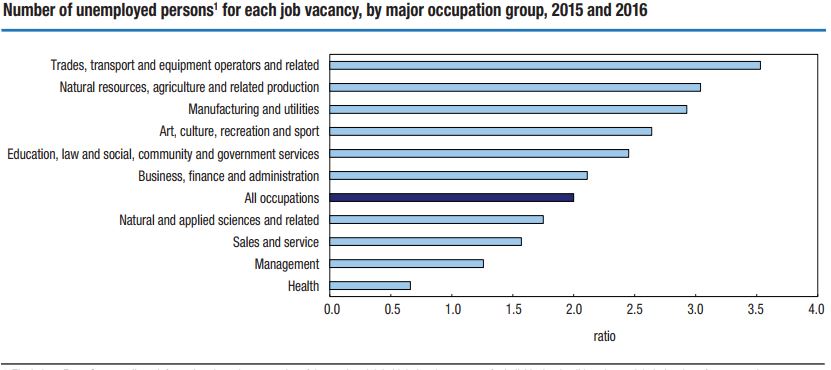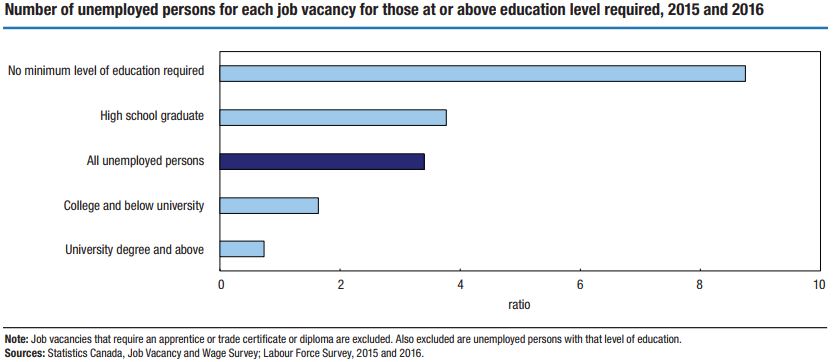The Economics and Statistics Division maintains archives of previous publications for accountability purposes, but makes no updates to keep these documents current with the latest data revisions from Statistics Canada. As a result, information in older documents may not be accurate. Please exercise caution when referring to older documents. For the latest information and historical data, please contact the individual listed to the right.
<--- Return to Archive
For additional information relating to this article, please contact:
November 10, 2017STUDY: LINKING LABOUR DEMAND AND LABOUR SUPPLY -- JOB VACANCIES AND THE UNEMPLOYED Recently, Statistics Canada released an analytical paper linking two key StatCan surveys: The Labour Force Survey and the Job Vacancies and Wage Survey. The purpose of the paper is to learn about demand and supply based on the joint availability of job vacancy and unemployment data over the past two years. The following questions are considered:
(1) To what extent are job vacancies and unemployment related?
(2) What can the unemployment-to job vacancy ratio tell us?
(3) To what extent do occupations differ in their relative degree of being "slack" or "tight"?
Statistics Canada's Labour force survey provides information on labour supply, as survey respondents describe their employment details, where as the Job Vacancy and Wage Survey shows the labour demand side of the story: employers indicate the extent to which the labour force is satisfying their employment needs, with added information on required skill level, education, and wage offering.
The detailed analysis of the two data sources reveals the following:
- The ratio of unemployed persons to job vacancy is sensitive to the measure of unemployed persons, and may not accurately reflect the underemployed, the discouraged workers, or other hidden unemployment (temporary layoffs, future job starters, part timers looking for full time work, etc)
- In general, slack labour markets (high ratio of unemployed persons relative to the number job vacancies) exist in Quebec and Newfoundland and Labrador, where as tighter conditions are found in BC. Worker mobility, language, and occupational / industry suitability could explain some of the inability to balance unemployment with vacancies.
- There are more job vacancies than unemployed persons in health occupations in all provinces, with health occupations having low unemployment and a low number of job vacancies. Conversely, the sales and service occupations report disproportionately high number of job vacancies and unemployed persons, suggesting that employers can easily find workers they need and workers can transition from job to job with relative ease.

Chart Source: Statistics Canada
- Trades, transport and related occupations have high unemployment and low vacancies across Canada. Similar to the construction industry, this signals a surplus of workers in these industries.
- Low job vacancy ratio may be indicative of occupations with high turnover, not necessarily occupations with a tight or a slack market in general.
- The ratio of unemployed persons to job vacancies falls as education levels increase. There are potentially 8.7 unemployed persons competing for each job vacancy that requires no minimum level of education, and a ratio of less than one for jobs requiring a University degree or above.

Chart Source: Statistics Canada
- Not all persons filling jobs are coming from the pool of unemployed. More workers started a new jobs in the last three months than the nubmer of reported vacancies, suggesting that jobs may become vacant and filled in the same month, or lengthy hiring processes may distort the reporting of the vacancy (whereby the vacancy is reported but hiring is in process long before the start date). Job vacancy numbers may not always clearly report the current situation.
The study concludes that analysis of these two surveys together can in the future help to distinguish between cyclical and frictional or structural trends, and how vacancies may indicate coming changes in the unemployment rate. The tightness or slackness of labour markets may be specific to province, occupation or education level. Lastly, the analysis shows that there are discrepancies between labour market conditions, particularly the unemployed, and the specific job vacancy situation.
For more information, see the study, "Linking Labour Demand and Labour Supply: Job Vacancies and the Unemployed."
<--- Return to Archive